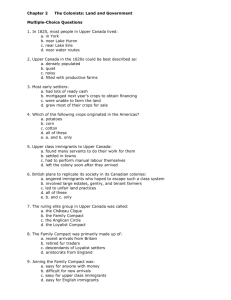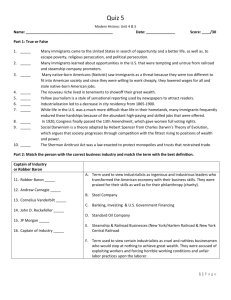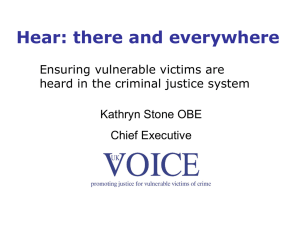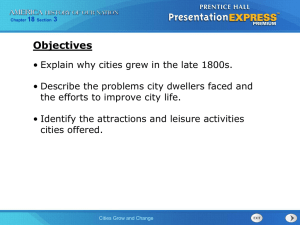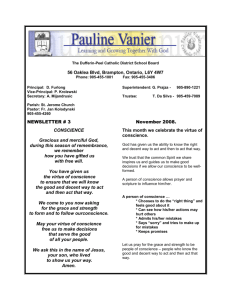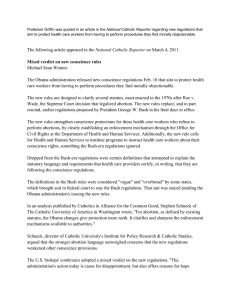Chapter 19 - Prong Software
advertisement
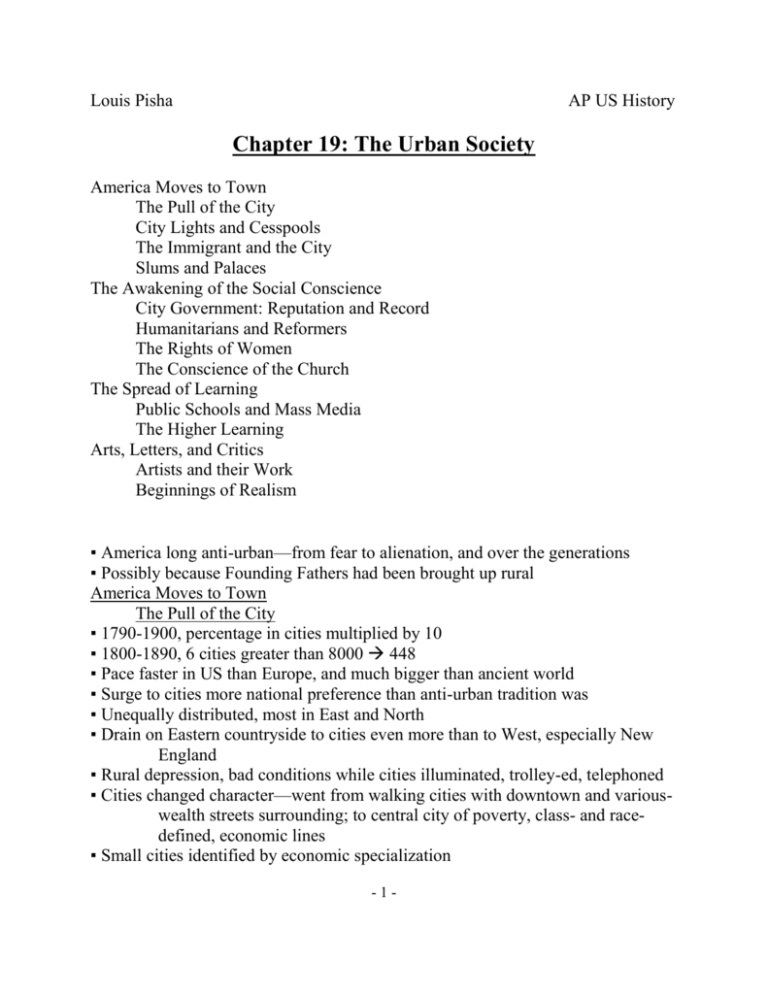
Louis Pisha AP US History Chapter 19: The Urban Society America Moves to Town The Pull of the City City Lights and Cesspools The Immigrant and the City Slums and Palaces The Awakening of the Social Conscience City Government: Reputation and Record Humanitarians and Reformers The Rights of Women The Conscience of the Church The Spread of Learning Public Schools and Mass Media The Higher Learning Arts, Letters, and Critics Artists and their Work Beginnings of Realism ▪ America long anti-urban—from fear to alienation, and over the generations ▪ Possibly because Founding Fathers had been brought up rural America Moves to Town The Pull of the City ▪ 1790-1900, percentage in cities multiplied by 10 ▪ 1800-1890, 6 cities greater than 8000 448 ▪ Pace faster in US than Europe, and much bigger than ancient world ▪ Surge to cities more national preference than anti-urban tradition was ▪ Unequally distributed, most in East and North ▪ Drain on Eastern countryside to cities even more than to West, especially New England ▪ Rural depression, bad conditions while cities illuminated, trolley-ed, telephoned ▪ Cities changed character—went from walking cities with downtown and variouswealth streets surrounding; to central city of poverty, class- and racedefined, economic lines ▪ Small cities identified by economic specialization -1- ▪ Towns in the West disappeared along with the miners, except if corporate ventures City Lights and Cesspools ▪ Tech advances brought more disadvantages, but from outside advantages only ▪ Bright arc lamps for streets, incandescent inside—safer at night, factories run at night, night amusement ▪ Streetcars first pulled by horses, and expanded city to have suburbs wherever the trolley ran—although contributed to economic segregation ▪ Streets paved at first with cobblestones, later asphalt ▪ Water supply and sewage were very low quality and contributed to staggering mortality rate and bad smells The Immigrant and the City ▪ Often thought of as the cause of the urban crisis, but actually quite similar, and more returned home to mother country ▪ Arrived in much greater numbers, greater tendency to congregate in cities than before, and from southern or eastern Europe—“new” immigrants ▪ Catholic or Jewish; often scapegoated ▪ Still, a large number there (NYC had 2.5 times as many Irish as Dublin), and huddled by nationality Slums and Palaces ▪ Cities grew with little control ▪ City slum designed to get maximum rent off the minimum cost—no sanitary, privacy, health, crammed like sardines ▪ Crime, prostitution, and gangs flourished—lawlessness, which was lessening in Europe, was getting worse in cities ▪ Veblen used phrase “conspicuous consumption” for leisure class—built magnificent palaces, with doormen, etc. ▪ Riis’s How the Other Half Lives versus McAllister’s Society as I Have Found It shows contrast between rich and poor The Awakening of the Social Conscience ▪ Feelings torn and consciences bruised City Government: Reputation and Record ▪ Bosses’ rascality has been a popular subject of Progressives, and although somewhat true, relatively not bad to politics of the day and considering the circumstances ▪ Large-scale utility expansion which had to be done but worth a fortune so politicians sold them to the highest bidder ▪ Huge power and revenue flowed in from anyone who needed protection ▪ Immigrants best supporters—jobs or favors in exchange for votes -2- ▪ Boss known of as someone they could take their troubles to, and loyalty to him ▪ Irish especially filled the role ▪ Some “good” people also supported the machine, like biz-men who were willing to cooperate with the machine or devotees of a party Humanitarians and Reformers ▪ Middle class missed the point that the poor were not poor because of moral shortcomings, but social workers began to make a connection to the lower class ▪ Adams started settlement houses and others followed—became spawning ground for women’s reformers, including Wald, Kelley, and Perkins ▪ Political battle for municipal reform began from middle class—founded goodgovernment organizations (goo-goos) ▪ National Municipal League launched and put forth structural reforms inspired by the model of biz efficiency, but inadequate—Pingree, Jones, Quincy, and Johnson (all mayors of different cities) provided laws protecting working-class interests like municipal ownership of utilities, unemployment relief, 8-hour day, minimum wage ▪ Some of those reformers became impatient with democracy though had noble goals The Rights of Women ▪ Long list of grievances, mostly about being kept in the sphere of the home ▪ Impossible to reconcile women’s rights with what they were demanded to do as subordinate wives ▪ For some, technology provided an escape—for others, domestic servants ▪ When a few women graduated from college, they had no place ▪ Women’s associations devoted to self-culture, from extremes of Association of Collegial Alumnae (selective) to General Federation of Women’s Clubs—often did not endorse suffrage ▪ Old-generation women leaders saw working women as equals, but newer-s did rarely—instead, narrowed all issues to suffrage and rejected their radical origins ▪ Wyoming 1890 first women suffrage state, Colorado, Utah, and Idaho soon after, but then it stopped and Congress became less favorable ▪ Also appealed to racism and nativism The Conscience of the Church ▪ Protestantism mostly defense of status quo, Social Darwinism, and the Gospel of Wealth—Henry Ward Beecher was a preacher ▪ Revivalism spread again, but this time professionals—Moody, Sankey, Talmage ▪ Working people drifting away from church—into pentecostal or millennial sects -3- ▪ Christian Scientists also sprang up under Eddy ▪ Salvation Army and YMCA ▪ Since immigrants Catholic, Catholic Church became more the working-class church, and Pope defended position of American labor ▪ Protestant clergymen began shaping new interpretation, Social Gospel—stressed social and pragmatic implications of Christianity and less spiritual— Episcopal Church took to it at first, then Baptists, then influenced everybody The Spread of Learning Public Schools and Mass Media ▪ Free education became foremost article in American faith, and expected to solve all country’s problems and take over functions of parents, police, and priests ▪ Private schools, like Catholic parochial schools, also expanded to serve immigrants ▪ School growth varied with distribution of wealth—most in urban and East— Southern schools horrible for whites and worse for blacks ▪ Illiteracy went from 17% to 11%, 1880 to 1900 ▪ Art museums founded by rich to diffuse refinement among people ▪ Libraries organized ALA and became more professional—Carnegie started library benefactions—NY Public Library, Boston Public Library, and Library of Congress all opened ▪ Journals or magazines for general public went from 100,000 circulation 1885 to 5½ million circulation 1905 ▪ Also rapid increase in newspapers, and became more vulgar to appeal to masses—by 1900, more than ½ newspapers in world—Pulitzer’s World and Hearst’s Journal The Higher Learning ▪ Before 1870, colleges mediocre, and professors nondescript—mostly for training of ministers—natural sciences neglected—no graduate or professional schools ▪ Harvard and Eliot took the lead in reforming—instituted free elective system, increase in number of science courses, labs, discussion periods, decline of authoritarianism ▪ Increased German influence in universities b/c shift to scientific and secular emphases—Johns Hopkins with graduate schools ▪ Archaeological Institute of America, Modern Language Association, etc. ▪ Medical and legal institutions were primitive but began to require college degree for admission and law improvements later -4- ▪ Prolific birth of colleges, especially state coed, women’s colleges, technological schools, from benefactors ▪ Mistaken conception of democracy led to idea of teaching all no matter how trivial ▪ Business leaders on boards of schools slow to acknowledge new scholar (teacher) so said should submit to will of board Arts, Letters, and Critics Artists and their Work ▪ Gilded Age was of excesses, especially molders of fashion ▪ On the other hand, genuinely free and original—cities gave challenge and opportunity ▪ Brooklyn Bridge daring—Olmsted designed Central Park ▪ Architect: Richardson ▪ Age of skyscraper—steel infrastructure—electric elevators—Sullivan ▪ White City at Chicago’s Columbian Exposition—all neoclassical/Federal (McKim, Mead, and White) except one of Sullivan ▪ LaFarge did stained glass windows, Homer and Eakins did common life paintings, Ryder painted sea and night Beginnings of Realism ▪ Literature of time tagged “genteel” and shallow, but boat was missed— Dickinson, Twain, Crane, Howells, James ▪ Twain (Clemens) showed diversity, adventure, tensions, and purposes of postCivil War America—masterpiece The Adventures of Huckleberry Finn ▪ Howells wrote even more –turned socialist and attacked social injustice ▪ James wrote about products of cultivated society, especially Americans vs. Europeans ▪ Adams philosopher-historian—main writing dealt with Jeffersonian period— incisive critique—how much society had changed from before Civil War -5-

